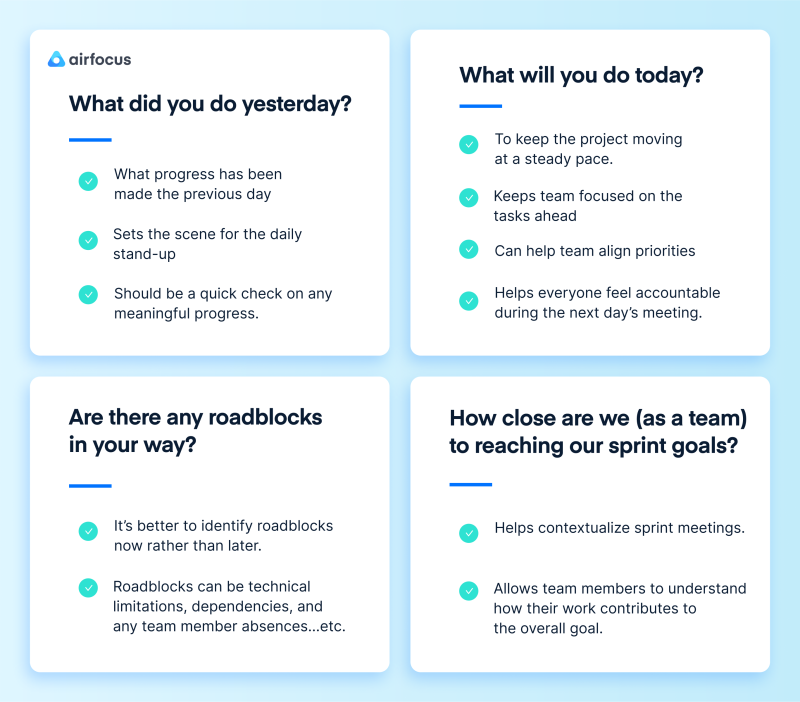Scrum Meeting
What is a Scrum Meeting
Definition of Scrum meeting
The Scrum meeting is executed daily, usually performed as a stand-up meeting.
Equivalent terms are daily scrum or simply standup. Participants include all scrum team members, such as product owner, Scrum Master and development team. It serves the purpose to share an individual’s progress of work and an estimation of the level of completeness until the next Scrum meeting. Any obstacles that detain the sprint goal should be expressed.
To confine any deviation it is significant for the Scrum Master to time-box the meeting and moderate arising issues appropriately.
A team can elevate its dynamic by introducing the Scrum ball, an item that is being tossed around for everybody’s turn to speak.
Who attends a scrum meeting?
Scrum meetings require everyone involved in the product’s development to attend. This includes the development team, the scrum master and the product owner. Stakeholders and other parties outside of the development process need not attend scrum meetings — unless they want to (and the rest of the team is happy to have them there!)
There are some scrum meeting types that slightly differ from this requirement. For example, when answering who attends a daily scrum meeting, you might want to let the product owner off the hook.
What are the different types of scrum meetings?
There are 5 different types of scrum meetings. Each type serves a specific purpose and therefore should be held at specific points during development.
The 5 types of scrum meetings are:
Sprint Planning Meeting - This is the first scrum meeting held during a project. The entire team will get together to develop realistic goals, build and prioritize the product backlog.
Daily Scrum Meeting - Held at the beginning of each day, this meeting serves as a progress update to ensure the team is still on track.
Sprint Review Meeting - At the end of each sprint, the team will demonstrate the current product iteration and discuss what has been achieved during the sprint.
Sprint Retrospective Meeting - Not to be confused with the sprint review, the retrospective meeting covers not only the work that has been done, but also how the work was performed. The intention is to identify what went wrong, what went right, and what can be improved.
Backlog Refinement Meeting - This meeting is the Grand Prix of agile prioritization. Backlog items are categorized and prioritized after technical discussions about deliverables and their requirements.
4 scrum meeting questions
You need to get as much information out as you can in a small amount of time during the daily scrum meeting. With that in mind, it’s always worth going into it with some form of agile scrum meeting agenda or template. This could be as simple as having a list of three questions that need answering during the meeting, such as:
What did you do yesterday?
What will you do today?
Is there anything getting in the way of your work?
How close are we (as a team) to reaching our sprint goals?
These simple questions will help streamline the daily stand-up meeting so only topics of importance are discussed.
Benefits of scrum meetings
For any agile team to be effective, they all need to be aligned with the vision for the project and business. They also need to be actively aware of what others on the team are doing at any one time to ensure high productivity, seamless collaboration, and a smooth development process.
Scrum meetings provide the team with an opportunity to realign and assess how well the project is running. During these meetings, any opportunities to improve, any reasons the team needs to pivot, and any issues that need fixing can be raised, allowing the team to open up meaningful discussions.
Agile and scrum teams who hold regular scrum meetings often produce higher quality products with less risk, increased transparency, while still being flexible enough to pivot when the project requires. Thanks to the streamlined and optimized processes, businesses also see a reduction in costs, time and resources, which contribute to a faster ROI.
Bonus: Daily scrum meeting agenda template
The daily scrum meeting focuses on four key talking points designed to catch everyone up quickly. These talking points are:
What did you do yesterday? - Discovering what progress has been made the previous day helps set the scene for the daily stand-up. This shouldn’t be a detailed breakdown but rather a quick check on any meaningful progress.
What will you do today? - You need to keep the project moving at a steady pace. Asking what team members will do helps refresh everyone’s minds and keeps them focused on the tasks ahead. Asking this during the stand-up also allows you to hold your team accountable during the next day’s meeting.
Are there any roadblocks in your way? - If there’s anything that can prevent today’s progress, it’s better to identify it now rather than later. Potential roadblocks can include technical limitations, dependencies, and any team member absences.
How close are we (as a team) to reaching our sprint goals? - Weighing up progress compared to your sprint goal helps contextualize sprint meetings. It allows team members to understand how their work contributes to the overall goal.

Examples of scrum meetings for remote teams
Running scrum meetings remotely will require some adaptations compared to in-person meetings. Quick meetings may run a little longer than expected, and additional tools may be required. Here are some things to keep in mind.
Sprint Planning
A remote sprint planning meeting will require a product management tool (like airfocus) that allows you and your entire team to see the product backlog, roadmaps, and your scrum/sprint boards. This can be shared through a video chat platform, or if you’re using a cloud-based product management platform, you can allow each team member to log in to view it on their own.
Sprint planning meetings may work better split into two parts when working remotely. The conversation probably won’t flow as smoothly as during an in-person meeting, so splitting sprint planning over two sessions allows extra time for clarifications and questions.
Daily Scrum
Daily video calls can easily replace the daily scrum meeting. These meetings are short and to the point, so there’s not much that needs to change for remote work.
That said, the daily stand-up meeting can be difficult to organize with distributed teams, especially if team members work in different time zones. Simply shifting daily updates to a messaging platform — like a dedicated Slack channel — allows teams to give updates on their schedule.
Sprint Retrospective
Remote retrospective meetings will need considerable thought to ensure they run smoothly. As with planning meetings, you’ll need a virtual tool that all members can see during the meeting. You’ll also need to prepare in advance by gathering data on sprint performance and mapping it to visualizations to help the team understand what they accomplished during the past sprint.
The retrospective meeting seeks to identify what went well and what could be better in the next sprint, so it’s worth remembering that some members may find it challenging to speak up online. Make sure to actively include everyone in the meeting for a complete picture of what happened during the sprint.
Backlog refinement
Remote teams may find it beneficial to perform backlog refinement regularly rather than having it as a specific event. A continuous approach helps keep the team focused on the right tasks rather than allowing reduced communication to cause problems. Again, this is best performed using online tools and messaging apps, though a game of Priority Poker through video call is always fun!

General FAQ

Glossary categories
Experience the new way of doing product management

Experience the new way of doing product management








